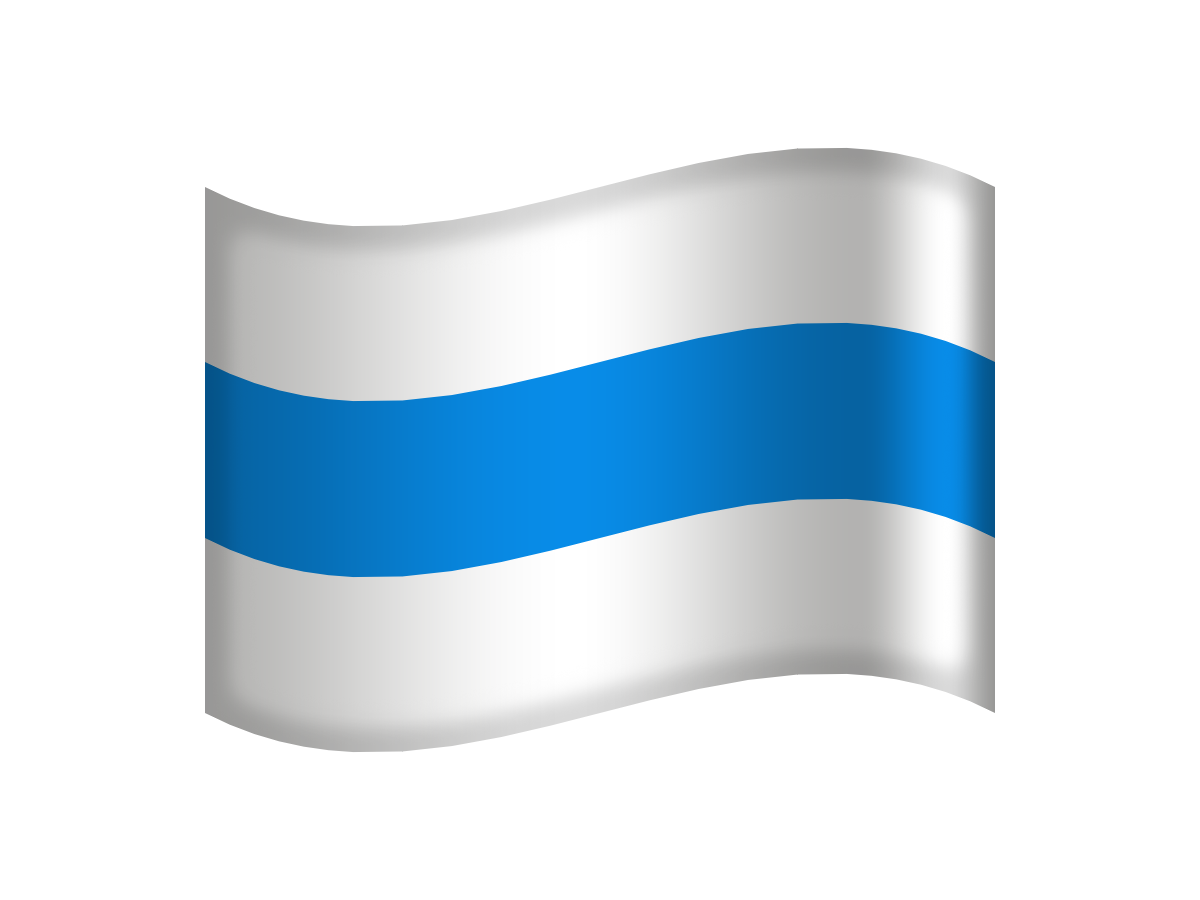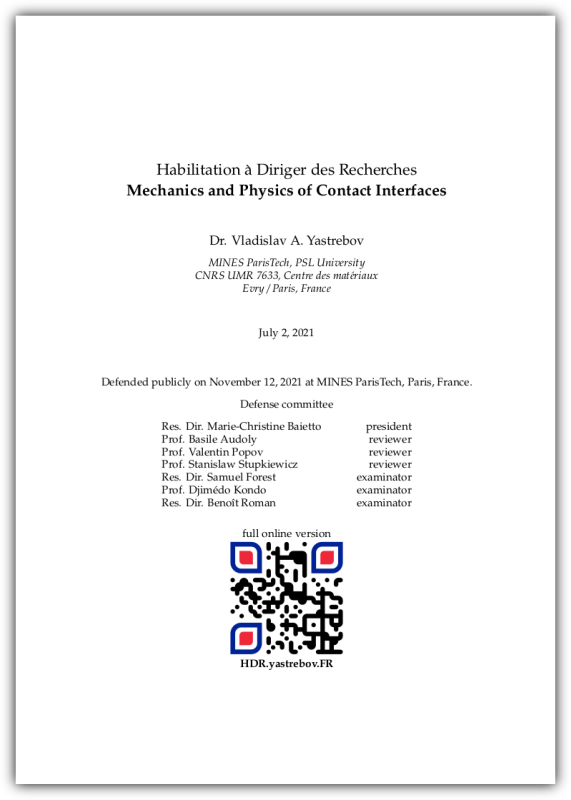Habilitation à Diriger des Recherches
Mechanics and Physics of Contact Interfaces
🇫🇷 Dr. Vladislav A. Yastrebov
 д.ф.-м.н. Владислав Александрович Ястребов
д.ф.-м.н. Владислав Александрович Ястребов
MINES Paris, PSL University, Centre des matériaux, CNRS UMR 7633, Evry, France
July 2, 2021, Paris, France
Defended publicly on November 12, 2021 at MINES ParisTech, Paris, France
Links: www.yastrebov.fr, ORCID, Google.Scholar, LinkedIn, HAL CV, arXiv CV
 |
 |
| download manuscript PDF (no animations, videos, and art section) | download presentation of the HDR defense |
Foreword
This “document” (or rather an interactive online source) gathers my major and minor scientific results as well as ideas and preliminary results for the future research. The document spans a period of approximately 10 years starting on March 25, 2011, when I defended my PhD thesis entitled “Computational Contact Mechanics: geometry, detection and resolution techniques” and ending on July 2, 2021. All the descriptions I provide here are supposed to be as concise as possible and most of them are focused on novel and interesting results only, therefore the mentioned papers do not reduce only to the reported results. At the same time, the “document” is crafted to be simple to navigate through, therefore the reader is invited to go through it online rather than in a rigid pdf format. The flexible online source of the document allows to easily navigate through different parts, provides a fast access to cited references and also to animated figures and videos.
The central topic of my research is the mechanical contact of solids. However, the derivatives of my research might seem to expand way beyond this research domain; the study of annihilation of elastic waves in asymmetric materials, construction of algorithms for microstructure of cemented carbides or the study on the origins of glacial earthquakes might seem to be irrelevant to mechanical contact at the first glance, but even in these projects the root or the origin lies within the scope of the contact mechanics. However, the main contributions of my research clusters within a small sub-domain of mechanical contact, namely in the contact of solids possessing rough surfaces.
The “document” is split into four parts.
- Research results
a short note and an illustration is provided for every scientific result, relevant references to our papers and/or presentations are also given. - Ideas
a very brief description is provided for some preliminary results and ideas, which I consider interesting but which were not yet fully (or not at all) explored because either the lack of time or of resources - Future research
research directions and concrete questions I plan to explore in the future are listed here - Miscellaneous
this part contains some CV-type information about teaching, supervision activities, and some community-targeted activities I carry out
Even though an HDR manuscript is a person-oriented document, I can write it only because there was a join effort of many people behind all the research results reported here. More importantly, I would not be able to reach this stage in my academic career without a strong and kind support of Georges Cailletaud and Boris Evgenievich Melnikov without whom this story would not happen. Thank you very much! All other people interaction with whom was and remains important to me are also acknowledged in the end of the document.
Whenever available, a French version is provided. Nevertheless, in all cases the English version is either equivalent or more elaborated than the French one. The style of the whole document is slightly heterogeneous and varies in correlation with the importance of the contribution reported in the section, therefore sometimes the style is a little bit informal.
Vladislav A. Yastrebov
🇫🇷 Evry / Paris, France
Table of contents
- Motivation and scope
- Research results
- Contact and multi-physics
- Wavy surface in contact
- Roughness and its representativity
- Contact area evolution and the role of roughness parameters
- Scale separation in rough contact
- Elastic-plastic contact of rough surfaces
- Trapped fluid in contact interface
- Creeping fluid flow in contact interface between rough surfaces
- Coupled flow through a wavy channel
- Electric contact between rough surfaces
- Greenwood’s elliptic model
- Size and material effects in indentation
- Model for electric-arc-induced damage in contactors
- Friction & wear
- Sliding in frictional interfaces: stability and regularization
- Slip stability under non-uniform pressure distribution
- Opening waves: sliding without slipping
- Supersonic slip pulses in Coulomb’s driven frictional interfaces
- Multiscale simulation of hardmetal interaction with rocks
- Pressure-dependent friction
- Materials
- Dynamics of architected materials
- Glacial earthquakes: bedrock/glacier/iceberg/ocean interaction
- Computational mechanics
- Contact and multi-physics
- Ideas & very preliminary results
- Perspective Research
- References
- Curriculum Vitae
- Acknowledgements
Motivation and Scope
My theoretical research is focused on phenomena related to mechanical contact between solids. My research is on the intersection between contact mechanics, tribology and numerical methods. Therefore, I work on computational algorithms related to contact mechanics, mainly using the finite element method. The computational frameworks that we construct with colleagues and students, we employ to understand better the interfacial physics of contact and friction. My first original results in the domain of computational mechanics were obtained during my PhD thesis and were related to optimization of detection and geometrical projection techniques, enhancement of interface geometries, and constructing a so-called partial Dirichlet-Neumann approach to handle contact problems. Further in this domain of computational mechanics, we developed a novel framework combining the extended finite element method (X-FEM) with mortar technique which enables us to handle tying, frictional contact and wear over overlapping domains and between boundary-fitted and embedded surfaces. This method is referred as MorteX and benefits from a novel stabilization technique for mixed problems that we developed. Further, we constructed an original monolithic finite element framework to solve problems of interfacial thin fluid flow in contact interface which takes into consideration the possibility of entrapment of fluid/liquid in the pockets surrounded by contact zones.
In modelling and simulations that we carry out, the target is set on the improvement of our understanding of micromechanical processes happening in contact interfaces. A part of these studies was carried out using an in-house boundary element method, for which we developed a novel technique for correction of discretization errors. This correction as well as a careful handling of surface representativity permitted us to establish a link between roughness parameters and the growth of the true contact area under the increasing normal load. Notably, we demonstrated the importance of higher-order spectral moments of the roughness for this area growth which were ignored in the most of recent studies. Using additional data and self-consistent homogenized model for transmissivity, a novel empirical law was obtained to link the permeability, pressure and roughness parameters. Using the coupled hydro-mechanical finite element framework that we constructed, we studied the effect of trapped liquids on the transmissivity properties of contact interfaces and obtained several original results including a non-local empirical permeability model and possible escape of the fluid from the trap under the increasing load. Few other contributions related to thermal/electric contact, roughness morphology, elasto-plastic contact were also made.
In other domains of solid mechanics and physics we made some contributions in the following topics: (1) the statics and dynamics of asymmetric materials, (2) dynamics of capsizing icebergs and their interaction with marine ice-sheets, (3) slip stability, slip triggering and arrest in frictional bi-material interfaces, (4) multiscale modelling of hardmetals in drilling applications, (5) material-arc interaction in electric contactors, (6) scale effects in indentation, and a few others.
A summary of other relevant activities is provided below.
Supervion: I co-supervised (1) 8 PhD candidates, 6 more PhD candidates I supervised at occasional basis, 4 postdocs, and several master students; one of my PhD students received the CSMA PhD award 2020 and the Hirn award 2020 for the best PhD thesis in tribology.
Teaching: I created an original 30h master/doctoral level course “Contact Mechanics and Elements of Tribology” and I also teach Continuum Mechanics, Molecular Dynamics and Dynamics of Dislocations.
Institutional and other responsibilities: I am a member of the CSMA Juniors committee since 2017 and a co-founder and a member of the Board of the new overlay journal JTCAM, which we created in 2017-2020 and launched in the summer 2020.
Scientific production: 26 peer-reviewed articles, 1 monograph.